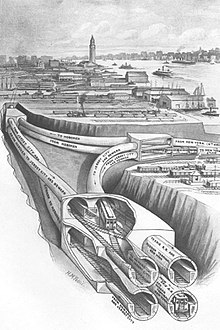Downtown Hudson Tubes
 1909 illustration of flying junction of Uptown Hudson Tubes in Jersey City which connect to Downtown tubes to the south | |
| Overview | |
|---|---|
| Location | Hudson River |
| Coordinates | 40°42′54″N 74°01′28″W / 40.7151°N 74.0244°W |
| System | PATH |
| Start | World Trade Center |
| End | Exchange Place |
| Operation | |
| Constructed | 1874-1908 |
| Technical | |
| Length | 5,650 ft (1,720 m)[1] |
| Track gauge | 1,435 mm (4 ft 8+1⁄2 in) |
| Electrified | Third rail |
| Lowest elevation | 97 ft (30 m) below sea level[1] |
| Tunnel clearance | 15.25 ft (4.65 m)[1] |
The Downtown Hudson Tubes are a pair of tunnels that carry PATH trains under the Hudson River between New York City and Jersey City in the United States. In lower Manhattan the trains travel to and from the World Trade Center station. In Jersey City the trains stop at the Exchange Place station. The tunnels were the second non-waterborne connection between Manhattan and New Jersey and were completed shortly after the uptown Hudson tubes.
The original tubes were built in 1908, to service the Hudson & Manhattan Railroad's Hudson Terminal in lower Manhattan starting on July 19, 1909.[2] When the World Trade Center was constructed, the original Hudson Tubes remained in service as elevated tunnels until 1970 when a new PATH station was built.[3] The downtown and uptown Hudson tubes were declared National Historic Civil Engineering Landmarks in 1978 by the American Society of Civil Engineers.[4] Some remnants of the tunnels under the original World Trade Center were removed during 2007 and 2008.[5]
See also
- Uptown Hudson Tubes
- Timeline of Jersey City area railroads
- List of fixed crossings of the North River (Hudson River)
- List of bridges, tunnels, and cuts in Hudson County, New Jersey
- Construction of the World Trade Center
- Hudson and Manhattan Railroad Powerhouse
- North River Tunnels
References
- ^ a b c Fitzherbert, Anthony (June, 1964). ""The Public Be Pleased": William G. McAdoo and the Hudson Tubes". Electric Railroaders Association, nycsubway.org. Retrieved 2010-01-18.
{{cite web}}: Check date values in:|date=(help) - ^ Port Authority of New York and New Jersey. "PATH:History". Retrieved 2010-01-19.
- ^ Carroll, Maurice (December 30, 1968). "A Section of the Hudson Tubes is Turned into Elevated Tunnel". The New York Times.
- ^ "History and Heritage of Civil Engineering: Hudson and Manhattan Railroad Tunnel". American Society of Civil Engineers. Retrieved 2009-03-13.
- ^ Dunlap, David W. (October 26, 2008). "Another Ghost From Ground Zero's Past Fades Away". The New York Times.
Further reading
- Burr, S.D.V. (1885). Tunneling Under The Hudson River: Being a description of the obstacles encountered, the experience gained, the success achieved, and the plans finally adopted for rapid and economical prosecution of the work. New York: John Wiley and Sons. Retrieved 2010-01-18.

